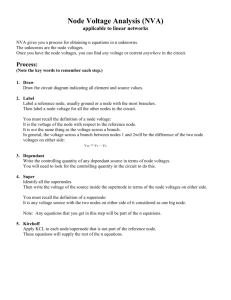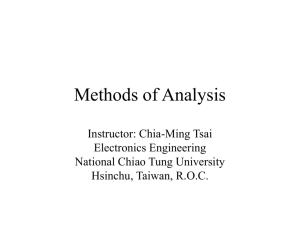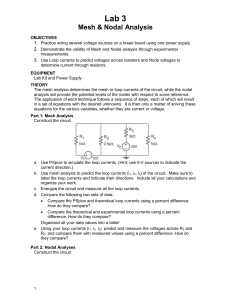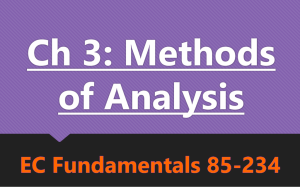Lecture 5
advertisement
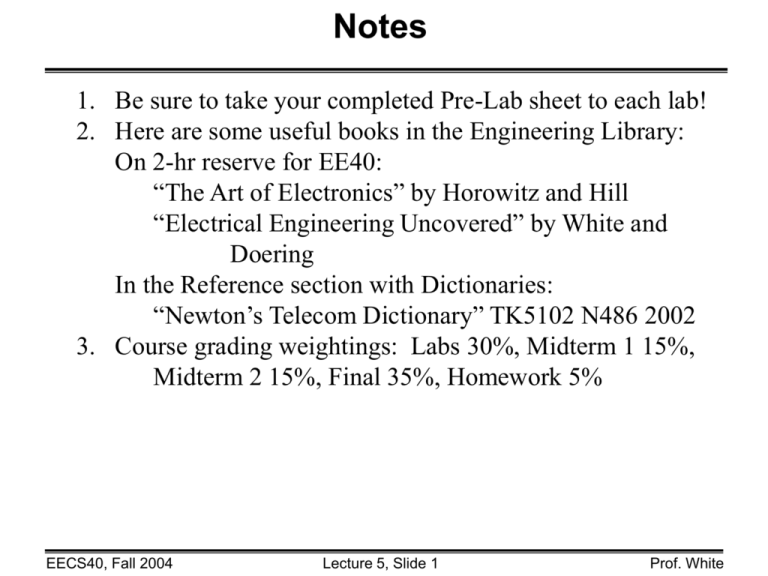
Notes 1. Be sure to take your completed Pre-Lab sheet to each lab! 2. Here are some useful books in the Engineering Library: On 2-hr reserve for EE40: “The Art of Electronics” by Horowitz and Hill “Electrical Engineering Uncovered” by White and Doering In the Reference section with Dictionaries: “Newton’s Telecom Dictionary” TK5102 N486 2002 3. Course grading weightings: Labs 30%, Midterm 1 15%, Midterm 2 15%, Final 35%, Homework 5% EECS40, Fall 2004 Lecture 5, Slide 1 Prof. White Lecture #5 OUTLINE • Node Analysis, examples • Node Analysis with dependent sources • Mesh Analysis Reading Chapter 2 EECS40, Fall 2004 Lecture 5, Slide 2 Prof. White Node-Voltage Circuit Analysis Method 1. Choose a reference node (“ground”) Look for the one with the most connections! 2. Define unknown node voltages those which are not fixed by voltage sources 3. Write KCL at each unknown node, expressing current in terms of the node voltages (using the I-V relationships of branch elements) Special cases: floating voltage sources 4. Solve the set of independent equations N equations for N unknown node voltages EECS40, Fall 2004 Lecture 5, Slide 3 Prof. White Nodal Analysis: Example #1 R 3 R1 + - V1 R2 R4 IS 1. Choose a reference node. 2. Define the node voltages (except reference node and the one set by the voltage source). 3. Apply KCL at the nodes with unknown voltage. 4. Solve for unknown node voltages. EECS40, Fall 2004 Lecture 5, Slide 4 Prof. White Nodal Analysis: Example #2 R1 Va R3 V 1 EECS40, Fall 2004 R2 I1 R4 Lecture 5, Slide 5 R5 V2 Prof. White Nodal Analysis w/ “Floating Voltage Source” A “floating” voltage source is one for which neither side is connected to the reference node, e.g. VLL in the circuit below: VLL Va Vb - + I1 R2 R4 I2 Problem: We cannot write KCL at nodes a or b because there is no way to express the current through the voltage source in terms of Va-Vb. Solution: Define a “supernode” – that chunk of the circuit containing nodes a and b. Express KCL for this supernode. Incorporate voltage source constraint into KCL equation. EECS40, Fall 2004 Lecture 5, Slide 6 Prof. White Nodal Analysis: Example #3 supernode VLL Va - I1 Vb + R2 R4 I2 Eq’n 1: KCL at supernode Substitute property of voltage source: EECS40, Fall 2004 Lecture 5, Slide 7 Prof. White EECS40, Fall 2004 Lecture 5, Slide 8 Prof. White Node-Voltage Method and Dependent Sources • If a circuit contains dependent sources, what to do? Example: iD 20 W 10 W EECS40, Fall 2004 200 W – + 5iD Lecture 5, Slide 9 – + 2.4 A 80 V Prof. White Node-Voltage Method and Dependent Sources • Dependent current source: treat as independent current source in organizing and writing node eqns, but include (substitute) constraining dependency in terms of defined node voltages. • Dependent voltage source: treat as independent voltage source in organizing and writing node eqns, but include (substitute) constraining dependency in terms of defined node voltages. EECS40, Fall 2004 Lecture 5, Slide 10 Prof. White Example: iD 2.4 A EECS40, Fall 2004 200 W – + 5iD Lecture 5, Slide 11 – + 20 W 10 W 80 V Prof. White EECS40, Fall 2004 Lecture 5, Slide 12 Prof. White Formal Circuit Analysis Methods MESH ANALYSIS (“Mesh-Current Method”) NODAL ANALYSIS (“Node-Voltage Method”) 0) Choose a reference node 1) Define unknown node voltages 2) Apply KCL to each unknown node, expressing current in terms of the node voltages => N equations for N unknown node voltages 3) Solve for node voltages => determine branch currents 1) Select M independent mesh currents such that at least one mesh current passes through each branch* M = #branches - #nodes + 1 2) Apply KVL to each mesh, expressing voltages in terms of mesh currents => M equations for M unknown mesh currents 3) Solve for mesh currents => determine node voltages *Simple method for planar circuits A mesh current is not necessarily identified with a branch current. EECS40, Fall 2004 Lecture 5, Slide 13 Prof. White Mesh Analysis: Example #1 1. Select M mesh currents. 2. Apply KVL to each mesh. 3. Solve for mesh currents. EECS40, Fall 2004 Lecture 5, Slide 14 Prof. White EECS40, Fall 2004 Lecture 5, Slide 15 Prof. White Mesh Analysis with a Current Source ia ib Problem: We cannot write KVL for meshes a and b because there is no way to express the voltage drop across the current source in terms of the mesh currents. Solution: Define a “supermesh” – a mesh which avoids the branch containing the current source. Apply KVL for this supermesh. EECS40, Fall 2004 Lecture 5, Slide 16 Prof. White Mesh Analysis: Example #2 ia ib Eq’n 1: KVL for supermesh Eq’n 2: Constraint due to current source: EECS40, Fall 2004 Lecture 5, Slide 17 Prof. White EECS40, Fall 2004 Lecture 5, Slide 18 Prof. White Mesh Analysis with Dependent Sources • Exactly analogous to Node Analysis • Dependent Voltage Source: (1) Formulate and write KVL mesh eqns. (2) Include and express dependency constraint in terms of mesh currents • Dependent Current Source: (1) Use supermesh. (2) Include and express dependency constraint in terms of mesh currents EECS40, Fall 2004 Lecture 5, Slide 19 Prof. White


